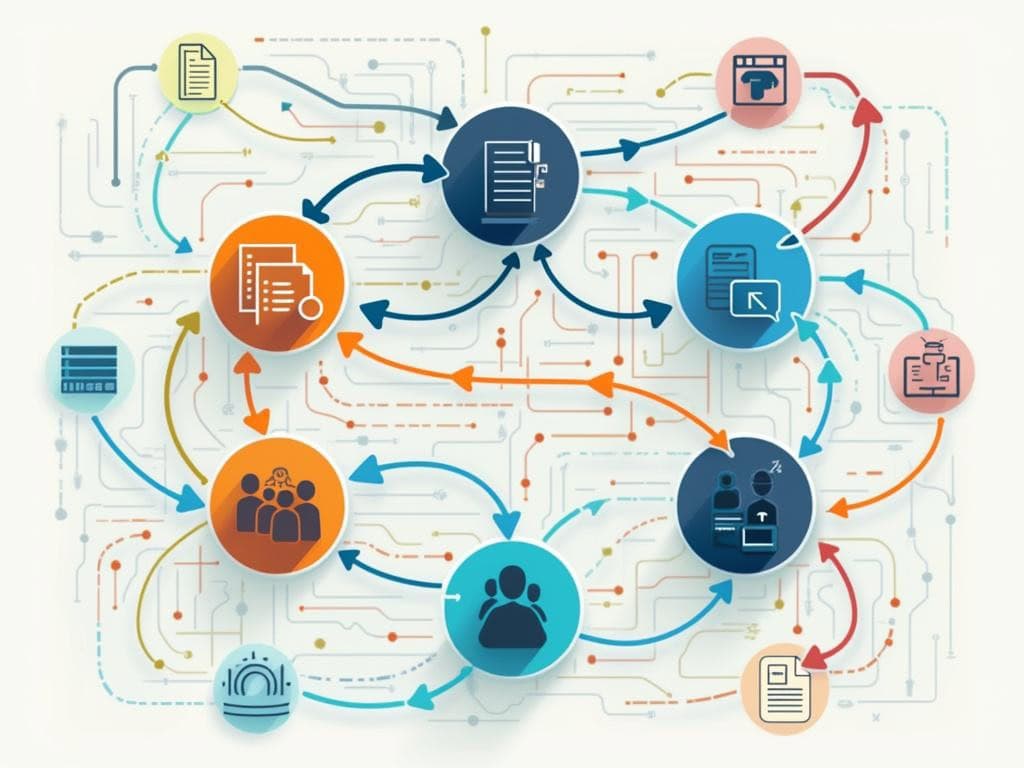
Transforming Organizations Through Knowledge Mapping
Knowledge mapping transforms how organizations capture, visualize, and leverage their intellectual assets. This approach enables more effective information management and strategic decision-making. By creating visual representations of knowledge flows, companies can achieve higher organizational efficiency, break down silos, and facilitate seamless information sharing across teams.
Key Takeaways
- Knowledge mapping improves business execution and decision-making by 39%
- Enhances customer support efficiency and employee productivity by 35%
- Reduces organizational silos by making knowledge visible across departments
- Identifies critical knowledge gaps and untapped resources within the workforce
- Creates visual connections between related information for faster problem-solving
Knowledge mapping techniques provide a structured approach to organizing information. The visualization process helps teams quickly identify connections between different knowledge assets. This leads to faster access to crucial information when needed.
You’ll find knowledge mapping particularly valuable during strategic planning sessions. Teams can spot gaps in their collective expertise and address them proactively. The process also highlights redundancies where multiple departments maintain similar information repositories.
Organizations that implement knowledge management systems with mapping components report significant improvements in onboarding efficiency. New employees gain quicker access to institutional knowledge, reducing their time to productivity.
The impact extends to innovation as well. By connecting previously isolated information sources, knowledge maps foster cross-disciplinary thinking and creative problem-solving. Teams discover unexpected relationships between concepts, leading to novel solutions for persistent challenges.
“Knowledge mapping revolutionizes organizational efficiency by transforming intellectual assets into visual blueprints, fostering seamless information sharing and breaking down silos. With a 39% boost in decision-making and a 35% enhancement in productivity, it empowers companies to uncover hidden knowledge and drive success.”
Types of Knowledge Maps
Knowledge mapping serves as a powerful visual tool that helps you capture, organize, and share critical information across your organization. By creating visual representations of where knowledge resides, you can more effectively manage this invaluable asset. Knowledge mapping enables you to identify experts, locate resources, and understand how information flows throughout your company.
There are several distinct types of knowledge maps that serve different organizational needs:
Key Knowledge Map Categories
Procedural Knowledge Maps document workflows and operational processes step-by-step. These maps help you standardize operations, onboard new employees faster, and identify inefficiencies in your business processes. When conducting project implementation phases, procedural maps prove especially valuable for maintaining consistency.
Conceptual Knowledge Maps explore relationships between ideas, concepts, and themes within your organization. They help you visualize connections that might otherwise remain hidden, fostering innovation and deeper understanding. These maps are particularly useful during strategic planning efforts when you need to connect disparate ideas.
Competency Knowledge Maps illustrate employee skills, behaviors, and training requirements. They help you identify knowledge gaps, plan training initiatives, and locate subject matter experts. When establishing critical success factors for projects, these maps help you identify who possesses crucial knowledge.
Here’s how these knowledge mapping approaches compare:
| Map Type | Primary Focus | Business Application | Key Benefit |
|---|---|---|---|
| Procedural | Workflows & Processes | Operations Standardization | Consistency & Efficiency |
| Conceptual | Ideas & Relationships | Innovation & Strategy | Creative Connections |
| Competency | Skills & Expertise | Talent Management | Skill Gap Identification |
Each type of knowledge map serves as a critical tool for revealing the practical application of information and organizational knowledge. The right approach depends on your specific objectives and the knowledge challenges you face. By implementing knowledge mapping strategically, you can boost decision-making by 39% while enhancing customer support efficiency and employee productivity by 35%.
When selecting the appropriate knowledge mapping technique, consider where your organization’s most valuable knowledge resides. Is it in your processes, concepts, or people? Often, you’ll need a combination of mapping approaches to fully capture your organization’s knowledge assets. This comprehensive approach helps prevent knowledge loss during organizational change and ensures critical information remains accessible to those who need it.
Expert Insight: When utilizing knowledge maps, assess your organization’s primary knowledge assets—whether they lie in processes, concepts, or employee expertise—to determine the most effective mapping approach. Procedural maps standardize operations, conceptual maps foster innovation, and competency maps identify skill gaps, ultimately enhancing decision-making and productivity. Combining these techniques strategically not only prevents knowledge loss during organizational changes but also promotes seamless access to critical information across your teams.
Business Impact and Benefits
Knowledge mapping transforms organizations by visualizing relationships between information, processes, and people. Companies implementing effective knowledge mapping strategies see measurable improvements across multiple business dimensions. You’ll discover tangible benefits that justify investment in this strategic approach to managing organizational intelligence.
The financial and operational impacts of knowledge mapping are substantial. Organizations report a 39% improvement in business execution and decision-making when knowledge assets are properly mapped and accessible. This happens because knowledge mapping eliminates information silos and creates clear pathways to critical information when needed for strategic planning decisions.
Customer support teams benefit greatly, with a 35% enhancement in efficiency after implementing knowledge mapping solutions. When support representatives can quickly locate answers through well-organized knowledge maps, resolution times decrease while satisfaction increases. Similarly, employee satisfaction and productivity see a 35% increase as knowledge mapping reduces frustration from searching for information and improves project collaboration.
Core Organizational Benefits
Knowledge mapping delivers several key advantages that strengthen your organization:
- Reduces organizational silos by making knowledge visible across departments
- Facilitates meaningful cross-team collaboration through shared understanding
- Identifies critical knowledge gaps that might otherwise remain hidden
- Highlights untapped knowledge resources within your existing workforce
- Creates visual connections between related information for faster problem-solving
- Preserves institutional knowledge when employees transition
The process of knowledge mapping itself creates opportunities for improvement as teams examine how information flows through your organization. By visualizing these knowledge pathways, you can identify bottlenecks, redundancies, and areas where knowledge transfer needs enhancement. This visibility enables continuous improvement of your information management practices.
The following table summarizes the key metrics that demonstrate knowledge mapping’s business impact:
| Business Area | Improvement Percentage |
|---|---|
| Business Execution & Decision-Making | 39% |
| Customer Support Efficiency | 35% |
| Employee Satisfaction & Productivity | 35% |
For maximum benefit, knowledge mapping should connect with your organization’s risk appetite and tolerance frameworks to ensure sensitive information receives appropriate protections while remaining accessible to authorized users.
Expert Insight: To amplify your organization’s effectiveness, leverage knowledge mapping to uncover relationships between information, processes, and individuals. This strategic approach has proven to enhance business execution by 39% and customer support efficiency by 35%, while also increasing employee satisfaction and productivity by 35%. By ensuring critical knowledge is visible and accessible, you can eliminate silos, boost collaboration, and drive continuous improvement across all dimensions of your business.
Strategic Tools and Technologies
You need the right tools to implement effective knowledge mapping across your organization. The right software solutions can transform how you capture, organize, and distribute valuable institutional wisdom. Knowledge mapping technology has evolved significantly, offering sophisticated features that enhance your ability to visualize complex information relationships.
Top knowledge mapping platforms provide distinct advantages for different organizational needs:
- MindGenius offers AI-powered capabilities that support 85 languages, making it ideal for global organizations.
- Nuclino provides a real-time collaborative workspace that facilitates team knowledge sharing.
- Guru delivers an AI-integrated knowledge management platform that automates knowledge discovery.
Most enterprise-grade knowledge mapping solutions fall within the $13-15 per user/month pricing range, making them accessible for organizations of various sizes. These platforms typically offer integration capabilities with your existing systems, including CRM, project management tools, and communication platforms.
Implementation Considerations
When selecting knowledge mapping tools, you should evaluate how they’ll support your strategic planning process. The right knowledge mapping solution connects seamlessly with your current workflows rather than disrupting them.
Consider these factors when evaluating knowledge mapping technologies:
- Scalability to grow with your organization.
- Visualization capabilities that match your mapping needs.
- User-friendly interfaces that encourage adoption.
- Collaboration features that support knowledge sharing.
- Analytics that measure knowledge utilization.
Knowledge mapping helps identify project roadblocks before they impact performance. By visualizing information flows and dependencies, you’ll spot potential issues and address them proactively.
The following table compares key features of leading knowledge mapping platforms:
| Platform | Key Strength | Best For | Integration Capability |
|---|---|---|---|
| MindGenius | Multilingual AI | Global teams | High |
| Nuclino | Real-time collaboration | Cross-functional projects | Medium |
| Guru | AI knowledge discovery | Customer support teams | Extensive |
Implementing robust knowledge mapping tools facilitates continuous improvement by making institutional knowledge accessible and actionable. With proper knowledge mapping technology, you’ll transform information from a static resource into a dynamic strategic asset.
Organizations that utilize knowledge mapping tools effectively are 25% more likely to achieve their strategic objectives and enhance organizational agility.
forbes.com
Market Potential and Growth
The knowledge mapping market is experiencing explosive growth as organizations recognize its strategic value. With the global knowledge management market valued at $655.8 billion in 2023 and projected to reach $2.1 trillion by 2030, knowledge mapping tools are becoming essential business investments rather than optional extras.
Knowledge mapping helps you visualize and organize your intellectual assets, creating clear pathways to critical information. This strategic approach allows you to identify where expertise resides in your organization and how knowledge flows between departments, significantly reducing time wasted searching for information.
Companies implementing effective knowledge mapping strategies report substantial benefits:
- 39% improvement in business execution and decision-making
- 35% enhancement in customer support efficiency
- 35% increase in employee productivity and satisfaction
As organizations face increasingly complex challenges, the demand for sophisticated knowledge mapping solutions continues to surge. The ability to quickly identify knowledge gaps and leverage knowledge mapping techniques provides a competitive advantage in rapidly evolving markets.
Strategic Investment Considerations
When evaluating knowledge mapping solutions, you’ll find various options with different pricing models and capabilities:
| Platform | Key Features | Price Range |
|---|---|---|
| MindGenius | AI-powered, supports 85 languages | $13-15/user/month |
| Nuclino | Real-time collaborative workspace | $13-15/user/month |
| Guru | AI-integrated knowledge management | $13-15/user/month |
These platforms offer integration capabilities with existing systems, making them adaptable to your current infrastructure. The relatively modest investment in knowledge mapping technology delivers substantial returns through improved information access and operational efficiency.
Forward-thinking organizations are conducting knowledge audits before implementing mapping solutions to ensure maximum effectiveness. This preparatory step helps identify critical knowledge assets and potential vulnerabilities before visualization begins.
By implementing comprehensive knowledge mapping initiatives, you’ll position your organization to better manage intellectual capital, enhance collaboration across teams, and create more resilient operational processes. The strategic importance of knowledge mapping will only increase as organizations continue to recognize how effectively mapping knowledge assets contributes to sustainable competitive advantage.

Implementing Knowledge Mapping: Practical Applications
Knowledge mapping transforms how you capture and use organizational intelligence. This strategic visualization technique helps you identify critical information assets and optimize their flow throughout your company. When implemented effectively, knowledge mapping serves as the foundation for better decision-making and operational excellence.
Best Practices for Knowledge Mapping Adoption
You’ll achieve better results by following these proven implementation approaches:
- Start with a clear objective: Define what specific organizational challenges your knowledge mapping will address
- Select the right mapping type: Choose between procedural, conceptual, or competency maps based on your goals
- Involve stakeholders early: Engage team members who possess valuable tacit knowledge
- Document both explicit and tacit knowledge: Capture formal processes and experiential wisdom
- Create visual representations: Utilize diagrams that clearly show relationships between knowledge assets
- Establish regular review cycles: Knowledge mapping requires continuous updates as information evolves
The implementation process becomes more manageable when aligned with strategic planning practices. Your knowledge mapping initiative should directly support broader organizational objectives like improved collaboration or faster onboarding.
Measuring the effectiveness of your knowledge mapping efforts is crucial. This table highlights key metrics to track:
| Metric Category | Specific Measurements | Target Improvement |
|---|---|---|
| Efficiency | Time spent locating information | 25-30% reduction |
| Collaboration | Cross-department knowledge sharing | 35% increase |
| Innovation | New ideas generated from knowledge connections | 20% growth |
| Training | Employee onboarding time | 40% reduction |
Successful implementation depends on selecting appropriate tools for your specific context. When evaluating knowledge mapping technologies, prioritize platforms that facilitate project collaboration and integrate with your existing systems.
Future trends in knowledge mapping include AI-powered knowledge discovery, automated knowledge gap identification, and enhanced visualization capabilities. These advancements will further strengthen the strategic value of knowledge mapping initiatives.
You’ll encounter common challenges during implementation, such as resistance to knowledge sharing and difficulty capturing tacit knowledge. Overcome these obstacles by establishing a culture that rewards knowledge contribution and employing techniques like storytelling to extract experiential wisdom.
The ROI of knowledge mapping comes from improved decision quality, reduced duplicated efforts, and enhanced continuous improvement capabilities. Organizations implementing comprehensive knowledge mapping report significant gains in operational efficiency and strategic alignment.






